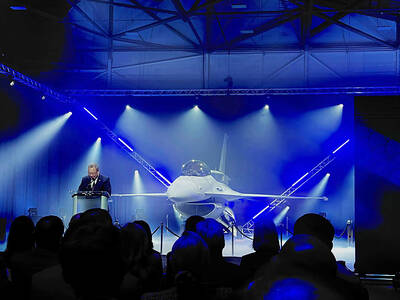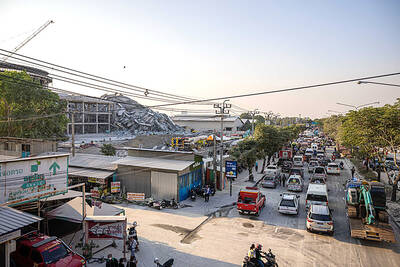Presidents Fidel Castro of Cuba and Hu Jintao (
The visit was the final stop on Hu's first Latin American tour, which also took him to Brazil, Argentina and Chile, where he attended an APEC summit.
Hu was welcomed at the Havana airport by Defense Minister Raul Castro, the president's brother and the No. 2 in the Cuban government. Hu then headed to the presidential palace for talks with Castro.
There, Castro, recuperating from a broken knee, welcomed the Chinese leader with a "Viva China!" from his wheelchair before inviting Hu into the government palace for private talks.
"We sincerely wish that the Cuban people march without surrender on the road to building socialism," the Chinese leader said.
Hu said his "visit will achieve our goal of deepening our friendship and financial cooperation," he said.
Both sides have hailed the importance of the 29-hour visit, which came as reformist China enjoys a booming economy, while Cuba, the only communist state in the Western Hemisphere, remains mired in a deep crisis.
Castro already has made it clear he expected the visit to bring significant investments to the Caribbean island nation, whose economy has suffered a steady decline since the collapse of the Soviet Union.
Only two hours after his arrival, Hu and Castro publicly signed 16 cooperation agreements, including one boosting the extraction of nickel from Cuba's top world reserve estimated at 800 million tonnes.
The agreement calls for building an extraction facility that will produce 20,400 tonnes of nickel and cobalt per year.
Located in the Cuban province of Holguin, 800km east of Havana, the Las Cariocas plant will boost Cuban nickel production from its current 75,000 tonnes a year to almost 100,000 tonnes, a long-sought goal of the Cuban government.
The plant will be 49 percent owned by China's Minmetal and 51 percent by Cuba's Cubaniquel monopoly.
China and Europe are the chief importers of Cuban nickel.
Other agreements signed by Hu and Castro favor the biotechnology, tourism, telecommunications, fishing, education and health sectors.

AIR SUPPORT: The Ministry of National Defense thanked the US for the delivery, adding that it was an indicator of the White House’s commitment to the Taiwan Relations Act Deputy Minister of National Defense Po Horng-huei (柏鴻輝) and Representative to the US Alexander Yui on Friday attended a delivery ceremony for the first of Taiwan’s long-awaited 66 F-16C/D Block 70 jets at a Lockheed Martin Corp factory in Greenville, South Carolina. “We are so proud to be the global home of the F-16 and to support Taiwan’s air defense capabilities,” US Representative William Timmons wrote on X, alongside a photograph of Taiwanese and US officials at the event. The F-16C/D Block 70 jets Taiwan ordered have the same capabilities as aircraft that had been upgraded to F-16Vs. The batch of Lockheed Martin

GRIDLOCK: The National Fire Agency’s Special Search and Rescue team is on standby to travel to the countries to help out with the rescue effort A powerful earthquake rocked Myanmar and neighboring Thailand yesterday, killing at least three people in Bangkok and burying dozens when a high-rise building under construction collapsed. Footage shared on social media from Myanmar’s second-largest city showed widespread destruction, raising fears that many were trapped under the rubble or killed. The magnitude 7.7 earthquake, with an epicenter near Mandalay in Myanmar, struck at midday and was followed by a strong magnitude 6.4 aftershock. The extent of death, injury and destruction — especially in Myanmar, which is embroiled in a civil war and where information is tightly controlled at the best of times —

China's military today said it began joint army, navy and rocket force exercises around Taiwan to "serve as a stern warning and powerful deterrent against Taiwanese independence," calling President William Lai (賴清德) a "parasite." The exercises come after Lai called Beijing a "foreign hostile force" last month. More than 10 Chinese military ships approached close to Taiwan's 24 nautical mile (44.4km) contiguous zone this morning and Taiwan sent its own warships to respond, two senior Taiwanese officials said. Taiwan has not yet detected any live fire by the Chinese military so far, one of the officials said. The drills took place after US Secretary

THUGGISH BEHAVIOR: Encouraging people to report independence supporters is another intimidation tactic that threatens cross-strait peace, the state department said China setting up an online system for reporting “Taiwanese independence” advocates is an “irresponsible and reprehensible” act, a US government spokesperson said on Friday. “China’s call for private individuals to report on alleged ‘persecution or suppression’ by supposed ‘Taiwan independence henchmen and accomplices’ is irresponsible and reprehensible,” an unnamed US Department of State spokesperson told the Central News Agency in an e-mail. The move is part of Beijing’s “intimidation campaign” against Taiwan and its supporters, and is “threatening free speech around the world, destabilizing the Indo-Pacific region, and deliberately eroding the cross-strait status quo,” the spokesperson said. The Chinese Communist Party’s “threats